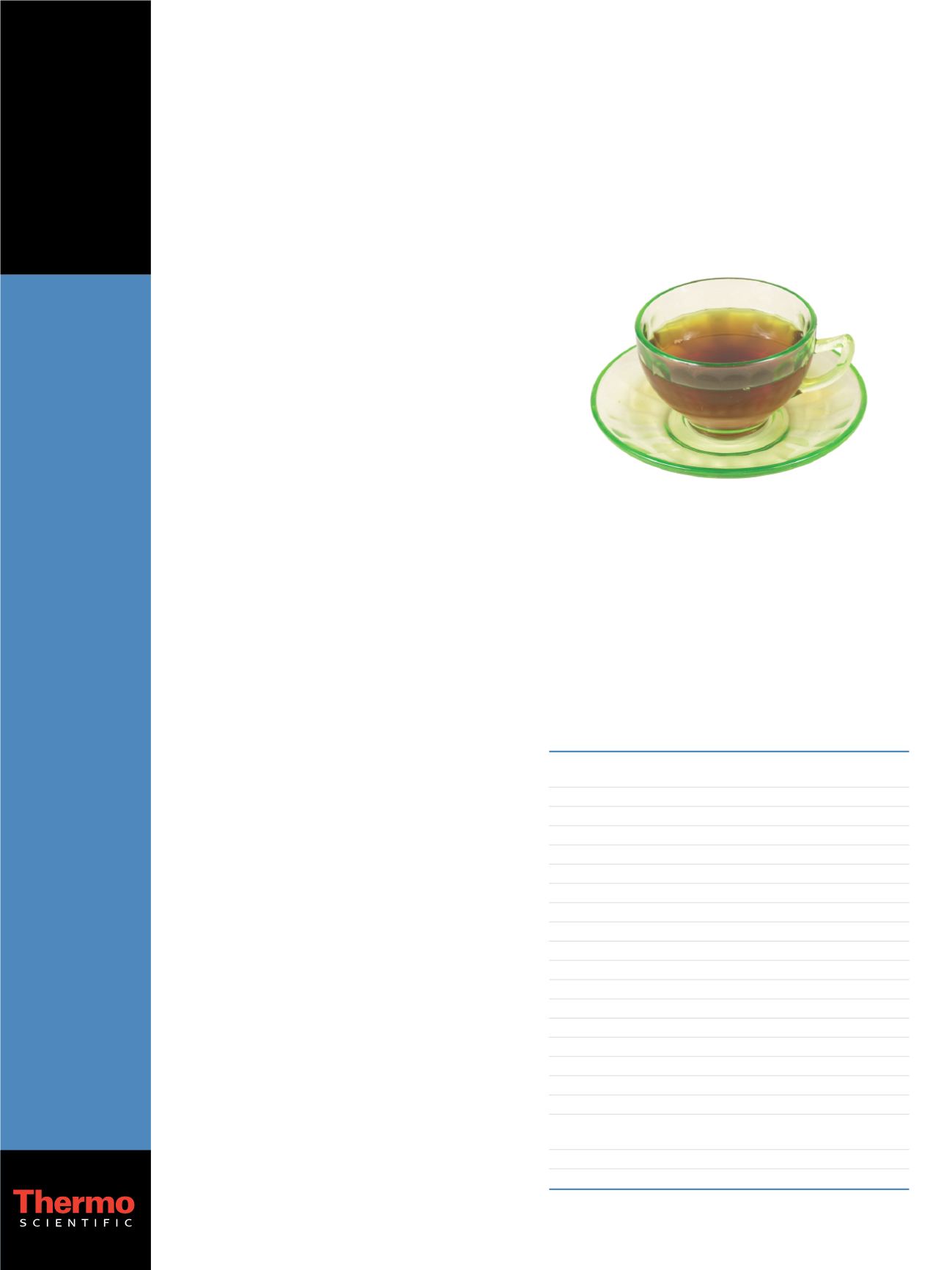
Multi-residue Pesticide Analysis in Green Tea
by a Modified QuEChERS Extraction and
Ion Trap GC/MS
n
Analysis
David Steiniger, Jessie Butler, Eric Phillips, Thermo Fisher Scientific, Austin, TX, USA
Introduction
Recently formulated pesticides are quite different in their
physical properties from their predecessors such as 4,4'-DDT.
Most of these newer pesticides are smaller in molecular
weight and were designed to break down rapidly in the
environment. Therefore, to successfully identify and
quantify these compounds in foods, more careful
consideration must be placed on the sample preparation
for extraction and the instrument parameters for analysis.
This study will cover the preparation of extracts and the
optimization of the analytical parameters of the splitless
injection, separation, and detection.
The determination of pesticides in fruits, vegetables,
grains and herbs has been simplified by a new sample
preparation method, QuEChERS (
Qu
ick,
E
asy,
Ch
eap,
E
ffective,
R
ugged and
S
afe), published recently as AOAC
Method 2007.01.
1
The sample preparation is simplified by
using a single step buffered acetonitrile (MeCN) extraction
and liquid-liquid partitioning from water in the sample by
salting out with sodium acetate and magnesium sulfate
(MgSO
4
).
1
QuEChERS can be used to prepare green tea
samples for analysis by gas chromatography/tandem mass
spectrometry (GC/MS
n
) on the Thermo Scientific ITQ 700
GC-ion trap mass spectrometer.
The study was performed to determine the linear ranges,
quantitation limits and detection limits for a partial list of
pesticides that are commonly used on green tea crops,
prepared in matrix using the QuEChERS sample preparation
guidelines. A splitless injection of 22 pesticides was made
in a single injection with detection in electron ionization
(EI) MS/MS. Since the extracts were prepared in MeCN, a
solvent exchange was made to hexane/acetone (9:1) prior
to conventional splitless injection.
2
Once the calibration
curve was constructed, multiple matrix spikes were analyzed
at levels of 37.5, 75, 150, 225, 600, or 1200 ng/g (ppb)
and low level spikes of 7.5, 15, 37.5, 75, or 300 ng/g (ppb)
to verify the precision and accuracy of the analytical
method. These concentrations were chosen based on the
requirements of various regulatory agencies.
Experimental Conditions
The sample preparation involves careful homogenization
of the sample. Extraction solvents must be buffered and
the powdered reagents measured at appropriate amounts
for the size of sample prepared. Some reagents cause an
exothermic reaction when mixed with water, which can
adversely affect the recoveries of target compounds. The
recommended consumables required for sample
preparation and analysis were rigorously tested (Table 1).
A list of the pesticides to be studied was created that
would address all of the various functional groups and
different physical properties of most pesticides. MS
n
parameters were optimized with the use of variable buffer
gas, the testing of the isolation efficiency, and adjustment
of the Collision Induced Dissociation (CID) voltage. A
surge splitless injection was made into a Thermo Scientific
TRACE TR-Pesticide III 35% diphenyl/65% dimethyl
polysiloxane column, (0.25 mm x 30 meter, and a film
thickness of 0.25 µm with a 5 m guard column).
Key Words
• ITQ 700
• Food Safety
• GC/MS
n
• Green Tea
• Pesticide
Residues
• QuEChERS
Technical
Note: 10295
Item Descriptions
TRACE
™
TR-Pesticide III 35% diphenyl/65% dimethyl polysiloxane column,
0.25 mm x 30 meter, 0.25 µm w/ 5 m guard column
5 mm ID x 105 mm liner (pk of 5)
10 µL syringe
Septa (pk of 50)
Liner graphite seal (pk of 10)
Ion volume, EI open
Ion volume holder
Graphite ferrule 0.1-0.25 mm (pk of 10)
Ferrule 0.4 mm ID 1/16 G/V (pk of 10)
Blank vespel ferrule for MS interface (pk of 10)
2 mL amber glass vial, silanized glass, with write-on patch (pk of 100)
Blue cap with ivory PTFE/red rubber seal (pk of 100)
Acetonitrile analytical grade (4L)
Hexane GC Resolv* (4L)
Acetone GC Resolv* (4L)
Organic bottle top dispenser
HPLC grade glacial acetic acid
50 mL Nalgene FEP centrifuge tubes (pk of 2)
Clean up tube:15 mL tube ENVIRO 900 mg MgSO
4
,
300 mg PSA 150 mg C18 (pk of 50)
50 mL PP Tubes 6 g MgSO
4
, 1.5 g CH
3
CHOONa (anhydrous) (pk of 250)
Clean up tube: 2 mL tubes 150 mg MgSO
4
, 50 mg PSA, 50 mg C18 (pk of 100)
Table 1: Consumables for QuEChERS sample preparation and GC/MS analysis


